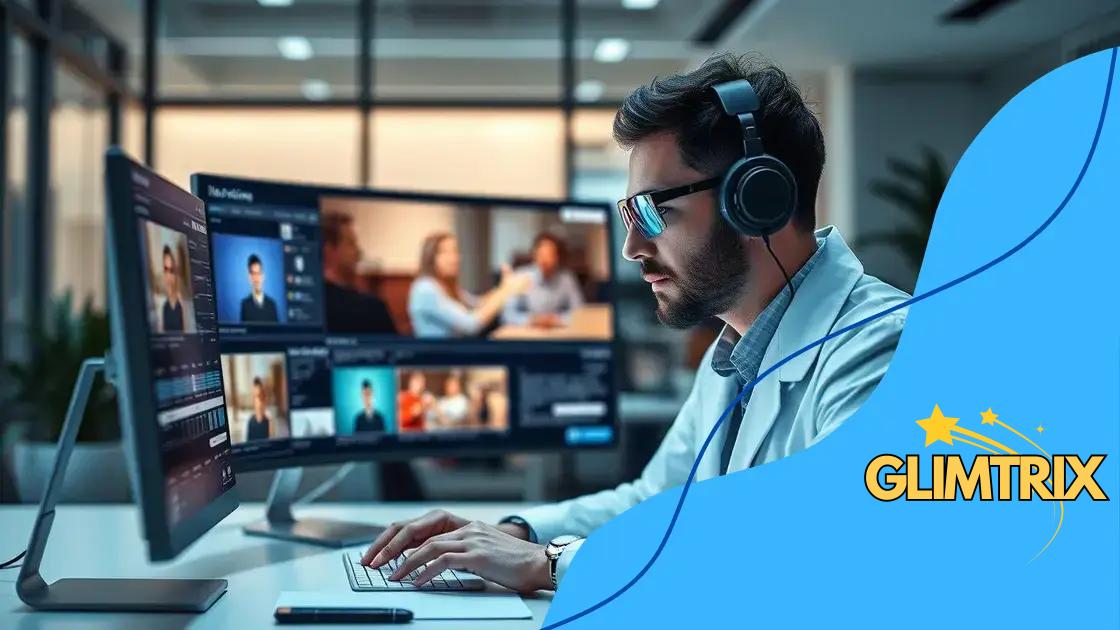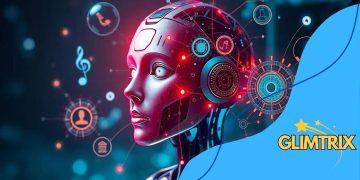AI detecting deepfake videos: ensuring authenticity online

AI detecting deepfake videos utilizes advanced algorithms to identify manipulated media by analyzing inconsistencies in visual and audio elements, ensuring reliability in digital content.
AI detecting deepfake videos is becoming essential as misinformation spreads rapidly online. Have you ever wondered how these false videos are created and detected? Let’s dive into this fascinating subject.
Understanding deepfake technology
Understanding deepfake technology is crucial in today’s digital age. It has transformed how we create and perceive media. This technology allows for the creation of lifelike synthetic media by using machine learning algorithms that manipulate audio and video.
How Deepfakes are Created
Deepfakes utilize artificial intelligence models, particularly deep learning algorithms, to generate realistic content. These models learn from large datasets of real images and videos. By analyzing these data, they can mimic faces, voice patterns, and even emotions.
Key Techniques Used
- Generative Adversarial Networks (GANs): A popular method that involves two neural networks competing against each other, resulting in high-quality outputs.
- Face Swapping: This technique involves replacing the face of a person in a video with someone else’s face.
- Audio Synthesis: AI can generate speech that sounds realistic, allowing audio deepfakes to match the visuals.
The implications of deepfake technology are vast, ranging from entertainment to serious concerns in security and misinformation. For example, celebrities and politicians have been targets of manipulated videos. Understanding the workings behind deepfake technology can help us recognize and combat its misuse. Moreover, it’s essential to develop tools to detect these manipulations, ensuring that consumers can trust the media they consume.
As we explore deeper into this topic, we find that deepfake technology has sparked debates on ethics and regulations. The power to create believable media brings significant responsibility. Ensuring that advancements in this field go hand in hand with ethical considerations is vital for maintaining public trust.
The role of AI in detecting deepfakes
The role of AI in detecting deepfakes is vital in combating misinformation. As deepfake technology evolves, it’s crucial to have equally advanced tools to identify these manipulations. AI algorithms are being developed specifically to analyze content and flag potential deepfakes.
How AI Detects Deepfakes
AI detection methods focus on analyzing inconsistencies in videos and audio. These tools can pick up subtle cues that human viewers might miss. For instance, AI can identify unnatural facial movements or inconsistencies in lighting and shadows.
Techniques Used in AI Detection
- Machine Learning: AI systems learn from large datasets of genuine and manipulated videos, improving their detection capabilities.
- Computer Vision: This technology helps AI analyze the visual aspects of media, detecting features that differentiate real content from fake.
- Audio Analysis: AI also examines audio tracks for irregularities, ensuring the speech matches the facial movements accurately.
These innovative approaches enhance the effectiveness of deepfake detection. Moreover, AI can work in real-time, scanning video feeds and flagging suspicious content instantly. As users become more aware of deepfakes, the demand for reliable detection methods increases.
In addition to automated tools, human reviewers play an essential role in the detection process. They can provide context that AI might not fully understand. Combining AI capabilities with human insights creates a more robust defense against the misuse of deepfake technology.
Current tools for deepfake detection

Current tools for deepfake detection are essential in the fight against misinformation. Several innovative technologies have emerged to help identify and analyze manipulated media. These tools vary in functionality but all aim to enhance our ability to recognize deepfakes effectively.
Popular Detection Tools
Among the most prominent tools is Deepware Scanner. This tool scans videos for signs of manipulation using AI algorithms. It provides users with detailed analysis and shows the likelihood of a video being manipulated.
Detection Techniques
- Video Integrity Tests: These tests analyze the consistency of frames in a video. They look for abrupt changes or inconsistencies that may suggest tampering.
- FaceForensics: This tool employs machine learning to detect anomalies in facial expressions and movements. It compares generated media against real videos to highlight discrepancies.
- Sensity AI: This service provides a unique platform for detecting, classifying, and tracking deepfake content. It uses extensive data sets to improve its accuracy.
Additionally, tools like Reality Defender focus on assessing online content, aiding users in navigating a sea of information. AI also plays a crucial role in developing these tools, with continuous improvements being made to their algorithms to stay ahead of evolving deepfake techniques.
It’s essential for users, companies, and platforms to utilize these detection tools to maintain the integrity of information shared online. With the increasing sophistication of deepfake technology, awareness and proper tools can help us safeguard against potential harm.
Challenges faced by AI systems
The challenges faced by AI systems in detecting deepfakes are significant and varied. As technology advances, so do the tactics employed to create convincing fake videos and audio. This constant evolution makes it difficult for AI to keep up.
Technical Limitations
One major challenge is the reliance on high-quality data for training AI models. If the dataset lacks diversity, the AI may not perform well on unfamiliar types of deepfakes. Additionally, low-quality videos can hinder accurate detection.
Adversarial Attacks
- Adaptive Deepfakes: Creators often modify their techniques to evade detection, making it hard for AI to recognize new patterns.
- Noise Introduction: Adding random noise to deepfakes can confuse AI systems and reduce their effectiveness.
- Real-time Detection: Processing videos in real-time is a challenge, as AI may need more time to analyze complex content.
Moreover, ethical concerns complicate the landscape for AI. Balancing privacy with detection efforts is tricky. Some algorithms might inadvertently infringe on individual rights while attempting to identify deepfakes. Finding a solution requires careful consideration and collaboration among technologists, lawmakers, and the public.
Lastly, user awareness also presents a challenge. Many users might not fully understand how deepfakes work or how to use detection tools effectively. Educating the public about these technologies is crucial in combating misinformation.
Future advancements in deepfake detection
Future advancements in deepfake detection hold great promise. As deepfake technology continues to evolve, so too must the methods we use to detect them. Researchers are focused on developing smarter, more adaptive systems to combat this issue.
Enhanced Machine Learning Algorithms
One significant area of improvement is in machine learning algorithms. Future systems are expected to use advanced neural networks that can better understand complex patterns in media. These algorithms will learn continuously, adapting to new types of deepfakes as they emerge.
Real-time Detection Capabilities
- Streaming Content Analysis: Future tools will likely analyze live video streams for signs of manipulation, helping identify deepfakes instantly.
- Better User Interfaces: As detection tools improve, so will their usability. Making these tools accessible to the average user is essential for widespread adoption.
- Integration with Platforms: Social media companies are expected to adopt advanced detection tools within their platforms, providing immediate alerts to users about potentially fake content.
Moreover, collaboration between AI experts and media platforms will be vital in creating an effective response to deepfakes. By sharing information and resources, these entities can develop more robust detection methods.
Another exciting prospect is the use of blockchain technology to authenticate videos. This could provide a secure way to verify the originality of content, making it harder for deepfakes to spread undetected.
FAQ – Frequently Asked Questions about Deepfake Detection
What are deepfakes?
Deepfakes are manipulated videos or audio recordings that use artificial intelligence to create realistic-looking but false content.
How does AI help in detecting deepfakes?
AI analyzes videos for inconsistencies, such as unnatural movements or audio mismatches, helping to identify manipulated content.
What challenges do AI systems face in detecting deepfakes?
AI systems struggle with evolving techniques used to create deepfakes, requiring constant updates and high-quality training data.
What future advancements can we expect in deepfake detection?
We can expect enhanced algorithms, real-time detection capabilities, and better collaboration between platforms to improve authenticity checks.





